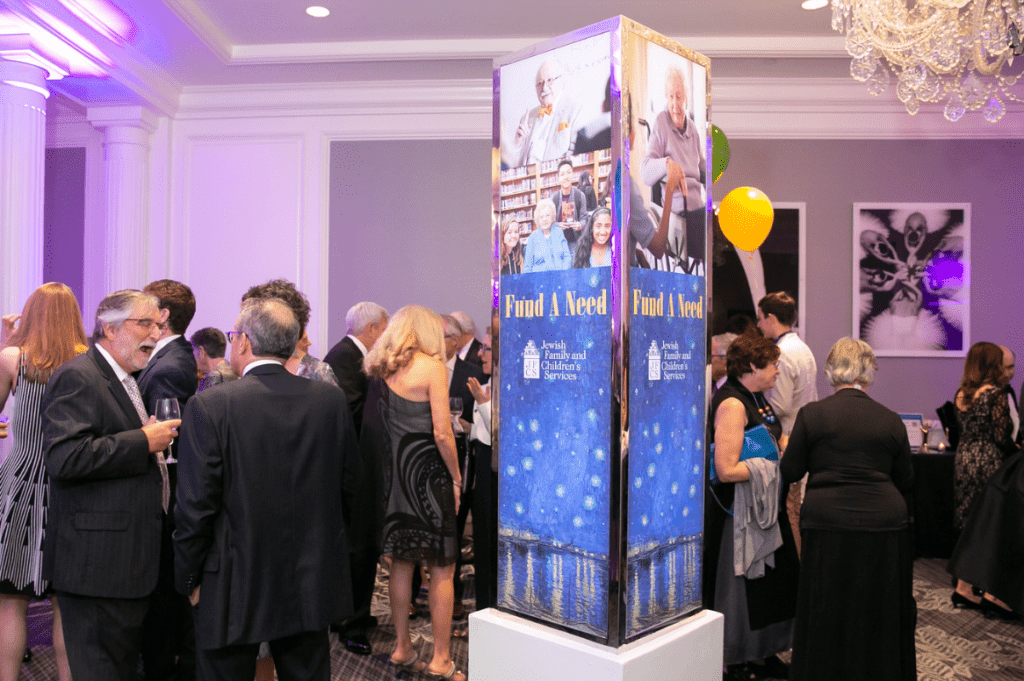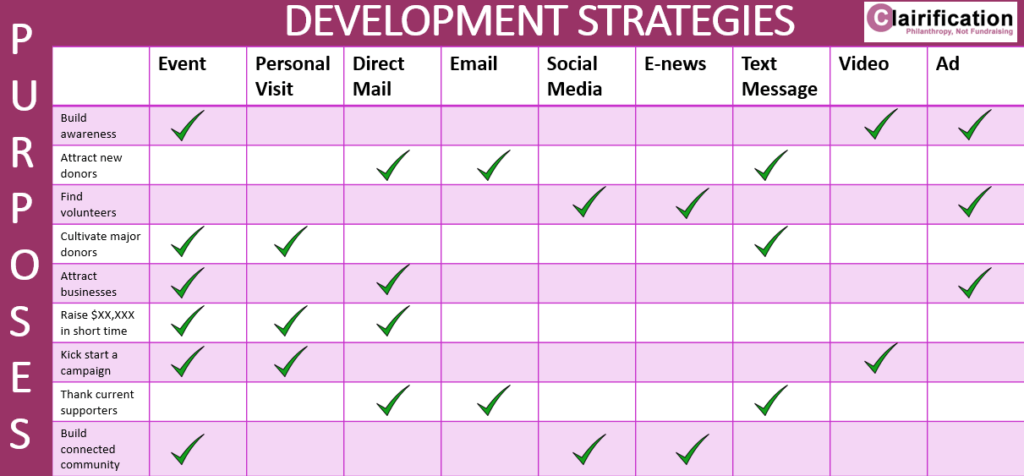
Let’s begin with the Big Kahuna piece of advice: Ask yourself WHY you want to do this event.
Were you to bring your event proposal to a wise shaman or mentor, this is the question they would ask you first – well before asking what theme or format you have in mind or what color scheme you want to use!
And yet this is the one question I find nonprofits failing to ask. Somehow staff and boards alike think events are simply an inevitable part of the diversified fundraising mix. Or maybe even the primary way to generate awareness and funds.
Events are neither inevitable nor primary. They are merely a means to an end.
And since they are extremely resource-intensive, it’s critical to think long and hard before embarking on a strategy that could potentially derail other more lucrative and cost-effective approaches.
Events have their place, to be sure; it’s up to you to put them in their place. You must take charge, lest they take charge of you!
What is Your End Goal?
You don’t buy a drill because you need a drill. More likely, you need to create a hole. Maybe the drill will do that best or, perhaps, there’s another more effective tool. It depends on the size and purpose of your desired hole. The same is true with nonprofit special events.
You don’t create an event for the sake of having one (no matter what one or more board members think would be swell.). No, you hold an event for a specific purpose. For example, to:
- Build awareness of your mission
- Attract new donors
- Find new volunteers
- Cultivate future major donors
- Attract corporate support
- Raise $XX,XXX in a short amount of time
- Kick-start a special campaign
- Thank current supporters
- Build a sense of connected community
Once you know your purpose(s) you’re better able to assess if an event is the most effective strategy to yield the desired result.
ACTION STEP (Fill in the blank): We want to hold an event to accomplish the following, in order of priority (try to limit to your top three objectives):
- __________________________________
- __________________________________
- __________________________________
What other Non-Event Strategies Will Reach Your Ends?
For decision-making purposes, I like to create a matrix with (1) purposes on one axis, and (2) strategies on the other axis.

I then complete the chart by making checkmarks in the relevant columns. [The above is just an illustrative example.]
Even though you think everything may be helpful to some extent, all strategies are not created equal for every purpose.
To avoid checking every box, which is a useless exercise, I recommend prioritizing and seriously considering just the top two to four strategies by conducting a quick-and-dirty ROI analysis.
[ROI] What are the Pros/Cons of Each Strategy?
Some strategies may be more likely to help you reach your ends than others.
Some strategies may be significantly more expensive and/or labor-intensive.
Some strategies may be more within your current wheelhouse than others.
You want to consider every angle before settling on your best marketing/fundraising approach.
For example:
EVENT PROS
- Events bring people together. They’re useful for creating and connecting community.
- Events facilitate in-person conversations. They’re useful for major donor cultivation, provided you plan ahead to assure quality conversation by making sure someone is assigned to greet and get to know the folks with whom you wish to build deeper relationships.
- Events are fun. They present a good way to build your brand, make folks feel warm and fuzzy about their engagement with you, and set up your follow-up appeal.
- Events can create memorable favorable impressions. If a picture is worth 1,000 words, a good event showcasing your vision, mission and values may be worth 10,000 words.
EVENT CONS
- Events generally reach a narrow number of people. If your goal is creating broad brand awareness, this may be too limiting. If your goal is to attract business sponsors, your target audience may be too small to entice them.
- Events are resource-intensive. While folks are planning the event, you may be losing opportunities for individual annual, major and legacy fundraising.
- Events, on average, cost 50 cents to raise a dollar. When you take into account the true costs, including staff time, most are lucky to break even. So if your goal is primarily to raise money, there are often less expensive ways to do so.
- Events run the risk of being one-and-done. It’s important to incorporate before, during and after tactics to assure it is part and parcel of your overall philanthropy facilitation efforts. You want transformation as a result, not merely one transaction.
Your Homework:
This advice was hard-earned, after three decades of putting on events for five different nonprofits where I served as the chief development officer. Over time, I learned a thing or two. It all seems very common sense now, but I’ve noticed somehow when we cross the thresholds of our offices we too often take off our common sense hats. Please don’t!
-
Determine your end goal.
-
Brainstorm other strategies that will help you reach your goal.
-
Consider the pros and cons of each strategy.
-
Decide if an event is, in fact, your best strategy to reach this goal. You want to get the best bang for your fundraising buck, right?
-
If so, move forward to plan the event!
In my next article I will share some top proven fundraising event planning tips. Watch this space!
Meanwhile… if you want to assure you get these tips and many more…
Please consider enrolling in Clairification School. You’ll receive all my original articles direct to your inbox weekly. You can access all my webinars and podcasts. I’ll send you Monthly Tips. I’ll give you bonuses — I love presents! And you’ll get all sorts of discounts and other surprises. Plus I’m available to answer quick email questions — all for just $100 for a full 12 months. As one of my students wrote to me: “This is the best bargain in fundraising.”
Photo by Claire Axelrad




